If you want to add interest, texture, and style to your indoor garden, look no further than the Silvery Ann pothos.
This tropical evergreen vine is native to Southeast Asia, features a stunning silvery variegation, and heart-shaped leaves.
What’s even better is that the Scindapsus Silvery Ann (one of the other names for this plant!) is easy to care for and doesn’t experience many pests, diseases, or problems.
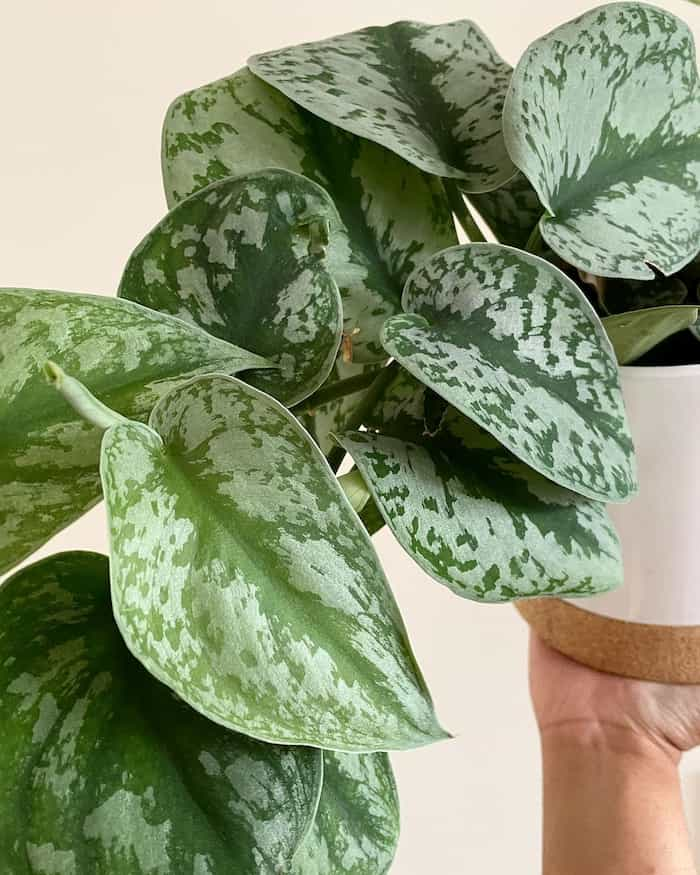
Table of Contents
How do you care for Silvery Ann pothos?
Silvery Ann pothos is an evergreen tropical vine that thrives in warm temperatures. It isn’t frost tolerant or cold hardy, which means it is generally grown indoors as a houseplant. Despite these temperature requirements, the Silvery Ann pothos is a rather low-maintenance plant that can live for years in your home.
1. Bright, indirect light
The Scindapsus Silvery Ann grows best when it is in bright yet indirect light. An east-facing window with a sheer curtain to help defuse the sun’s rays is typically the best location for this plant. If you allow the Silvery Ann to grow in direct light, the foliage will start to burn and discolor.
Because this plant can tolerate some medium lighting conditions, it may be tempting to set it in a low-light area. However, this can cause the plant to experience stunted growth, as well as increase the chance of its foliage losing its variegation.
2. Occasional watering
As with other Scindapsus plants, the Silvery Ann cannot handle soggy soil and they do not like to have their roots kept wet. Much like when overwatering a pothos, this is one of the quickest ways to kill the Silvery Ann pothos.
Thankfully, you can prevent this from occurring by waiting until the soil dries out a little before watering again.
3. Suitable temperatures
Scindapsus Silvery Ann are native to areas where the weather is warm all year round. Because of this, you will need to ensure the plant is growing in an area where the temperatures stay between 65 and 85 degrees Fahrenheit even in the colder months.
Additionally, keep the Silvery Ann pothos away from indoor areas where the temperature fluctuates. This includes near heating and cooling vents, next to drafty windows, and near exterior doors. Extreme temperature fluctuations can cause the plant to go into shock, which can kill the Silvery Ann pothos.

4. Adequate humidity
While the Silvery Ann pothos can grow just fine at the humidity level typically found in homes, it grows best when the humidity is above 50-percent. If you want to increase your home’s humidity level, consider using a humidifier or simply setting the Silvery Ann pothos on a drip tray.
If you decide not to use either a humidifier or drip tray, you may have to mist the Silvery Ann pothos during the winter when the humidity levels are low due to heaters drying the air, as well as during periods of hot dry summers.
5. Well draining soil
The soil that the Silvery Ann pothos is growing in is vitally important to the overall health and wellness of your plant. Because this plant cannot tolerate soggy soils, you will need to plant the Scindapsus Silvery Ann in a growing medium that drains well.
A mixture of equal parts potting soil, perlite, and peat moss works well for this plant.
6. Container with drainage
As with the soil, the container the Silvery Ann pothos is growing in can greatly affect the moisture level. If the pot doesn’t have drainage holes at the bottom, all that excess water has nowhere to go and it will merely sit inside the container and increase the chance of fungal diseases, such as root rot.
The best pot for the Silvery Ann pothos is one with drainage holes located directly at the very bottom. Never use a container with no drainage holes or ones that are located on the side.
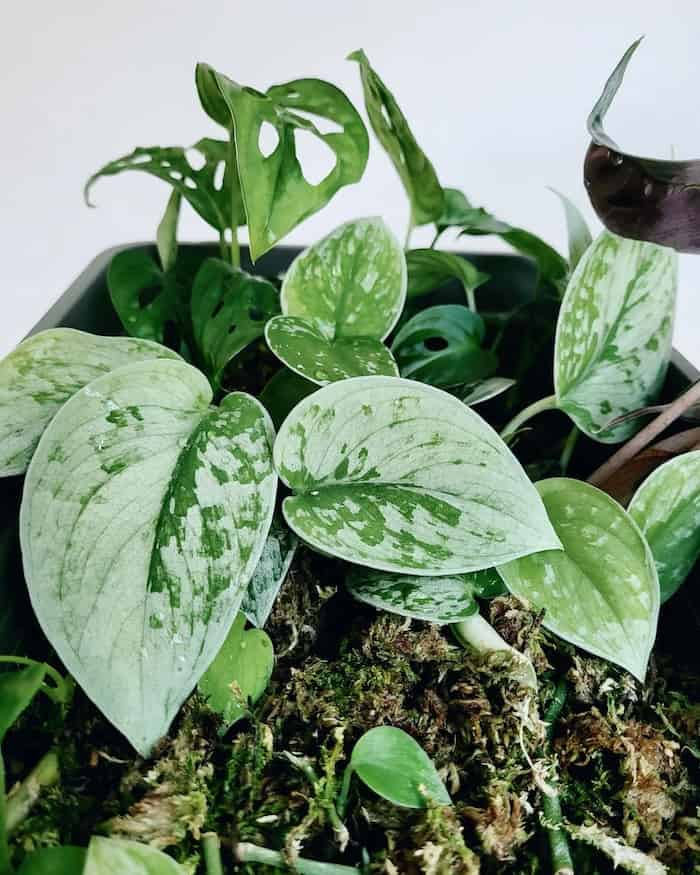
7. Check for disease
Silvery Ann pothos are not susceptible to many diseases, though the ones that can attack this plant are directly linked to overwatering and poor drainage. The one disease you really have to look out for is root rot, which occurs when the plant has soggy roots and soggy soil.
While this disease is a serious one that can be fatal to the Silvery Ann pothos, it is also completely preventable. The best defense against root rot is to ensure you are not overwatering the plant, and that it is growing in well-drained soil and container. If you have been overwatering the plant, immediately stop watering the plant and let the soil dry out before watering it again.
If you have continuously overwatered the plant and are starting to see signs of root rot, such as limp and/or discolored leaves, leaves falling off the plant, water blisters, stunted growth, and an unpleasant odor, it may be too late to save the plant. You can, however, try to revive it by removing the Silvery Ann pothos from its pot, getting rid of all the soggy soil, and then repotting it in a sterilized container with fresh soil.
8. Avoid pests
While not a common problem, scales, spider mites, mealybugs, and other sap-sucking insects can attack the Silvery Ann pothos. The good news is that these pests are usually easy to control and rarely threaten the life of your houseplants. Look for signs of these pests and then treat the Silvery Ann pothos with horticultural oil.
As long as the Silvery Ann pothos is healthy, it can withstand an attack from the insects, and typically won’t experience any long-term effects. Just make sure to quarantine the plant away from your other plants if the insects have not yet made their way to them.
9. Regular fertilizer
While not a heavy feeder, the Silvery Ann pothos can be given fertilizer once a month during the plant’s growing season. Starting in the spring, apply an all-purpose liquid fertilizer to the Silvery Ann pothos once a month until the fall. Make sure to apply the dosage at half its strength.
Keep in mind that you can give the Silvery Ann pothos too much fertilizer, which can cause a wide array of issues, including stunted growth and yellowing leaves. For this reason, similar to when you fertilize a pothos, take care not to overfeed the plant and never apply more than the recommended dosage listed on the bottle.
10. Repotting when needed
The Silvery Ann pothos don’t need to be repotted regularly. In fact, you will only have to repot the pothos plant when it starts to outgrow its current growing condition, which is typically every few years. With that said, however, you may have to repot due to an emergency situation, such as disease.
When you do need to repot the plant, make sure to use a pot that is only about 2 inches wider than its current pot. Using a pot that is larger than that causes a slew of issues and makes it harder for the plant to suck up and absorb moisture and nutrients.
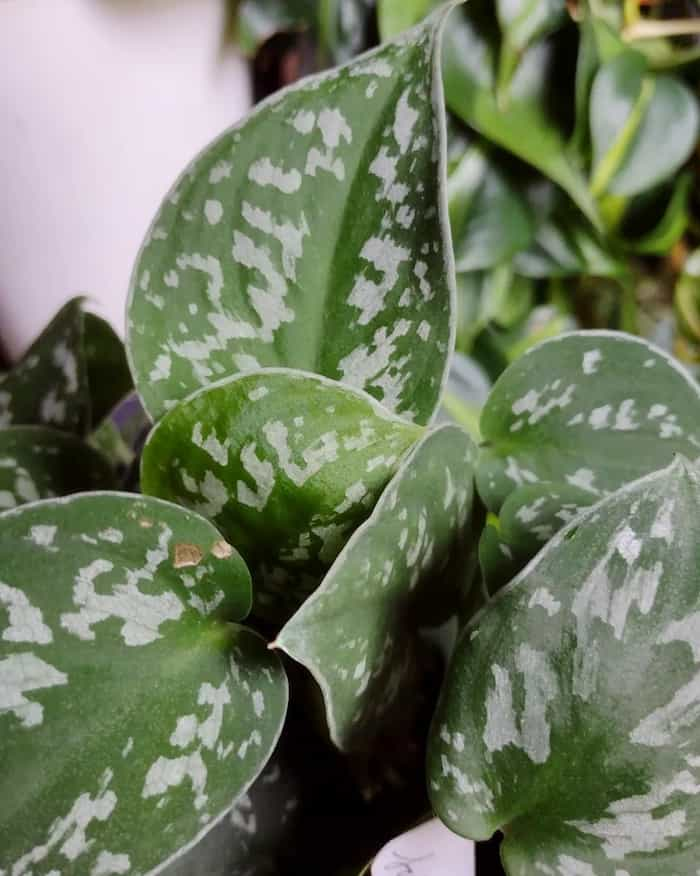
11. Occasional pruning
Pruning isn’t required, but it can help maintain the Silvery Ann pothos’ growth and even stop the plant from becoming leggy. Leggy is when a plant has more stems than leaves. With proper pruning, you can stop this from occurring and encourage the plant to have a more bushier and fuller appearance.
If you do decide to prune the Silvery Ann pothos, the same strategy applies as when you prune any pothos. That is, use a pair of sharp pruning shears that are clean and sanitized and decide where you will be pruning and make your cut above the leaf node. If the stem is healthy, you can use it to propagate the plant and increase the amount of Silvery Ann pothos you use.
12. Propagating when you like
Silvery Ann pothos are an easy-to-propagate plant that can be rooted either via water or soil. This plant is propagated using the stem method, which does require removing a portion of the stem. The good news is that if you are merely pruning the Silver Ann pothos to control its size, you can use the pruned stems to create new plants.
Consider using rooting hormone when propagating the Silvery Ann pothos. While this isn’t a requirement, it can help increase the amount of time it takes for the cutting to root and it can be used with both soil and water rooting methods. All you have to do is dip the cut end of the stem into the rooting hormone and then plant as desired.
The best time to propagate the Silvery Ann pothos is during the spring or summer months. This is when the plant is typically the strongest and growing actively, which means it is much more likely to handle the cutting with no problem. Remember that you should only ever propagate pothos from a strong and healthy plant.
Is Silvery Ann a pothos?
The Silvery Ann pothos is actually not a pothos at all and belongs to the Scindapsus genius. Both the Scindapsus and the pothos are members of the Alum family, have the same general growing requirements, and even have a similar appearance. All of this can make it difficult to tell whether a plant is a Scindapsus or a pothos.
The easiest way to tell whether it is a Scindapsus or a pothos is by the color of the plant’s variegation. Scindapsus plants, such as the Silvery Ann and Silver Splash Pothos, have silver-colored variegations, while the pothos have variegations in hues of white, green, and yellow.
Another difference between the two types of plants is that the pothos leaves are thinner and not as textured as the Scindapsus leaves.
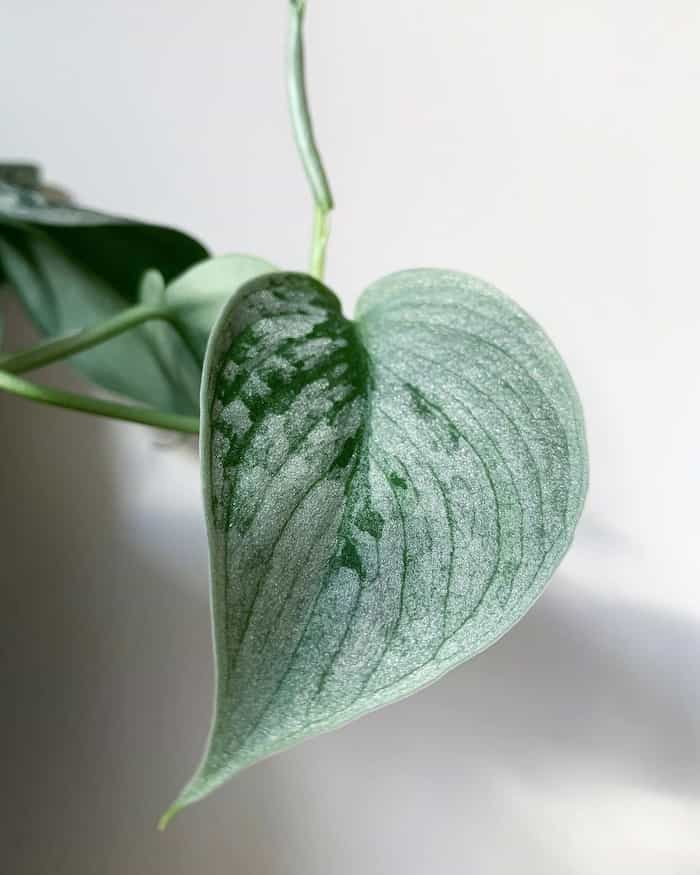
Is Silvery Ann the same as Exotica?
Silvery Ann pothos and Exotica are not technically the same plant, and are instead different cultivars of the Scindapsus. Because they do come from the same plant, they have the same growing requirements and have a similar appearance. With that said, however, there are some major differences between the two cultivars.
The Silvery Ann pothos has softer leaves than the Exotica and it has much more noticeable silver variegation. In fact, some of the leaves have more silver on them than green, and it is not uncommon for the leaf to be more silver than green in color.
Silvery Ann pothos vs Satin pothos
The main difference between the Silvery Ann pothos and Satin pothos is that the Silvery Ann pothos produces foliage that is more variegated. The silver variegation of the Silvery Ann is more disorganized than that of the Satin pothos, which produces a more controlled or regular pattern. The Silvery Ann’s leaves are also smaller.
Silvery Ann pothos and Satin pothos are two extremely similar cultivars of the same plant. While they do share a lot of similarities, including the same growing conditions, they are not identical in their appearance.
Another difference, in addition to those mentioned above, is the mature size of the plants. The Silvery Ann pothos is a little smaller, having a mature height of about 6 feet and a mature width of about 3 feet. The mature height of the Silver Satin pothos is, on average, 10 feet and the mature widget is 4 feet.
Silvery Ann vs Silver Satin pothos
The main difference between the Silvery Ann and the Silver Satin pothos is that the Silvery Ann has a much more silver variegation that is in a more chaotic pattern, along with the fact that it has smaller leaves. The Silver Satin pothos is more green than silver and has larger leaves.
Silver Satin pothos are also known as Satin pothos, which means they have the same differences to the Silvery Ann pothos as what is listed in the section above.
Are Silvery Ann pothos rare?
The Silvery Ann pothos is considered rare, and it can be difficult to find. This is especially true if you are limited to where you can purchase plants from. That doesn’t mean you won’t be able to find the Silver Ann pothos, though it could take some time to find this rare yet stunning plant.
You may also have to search outside your local area to find the Silvery Ann pothos. In most cases, it is always best to obtain your plants from a local source. Unfortunately, this isn’t always possible, especially if the plant you are looking for is rare.

That is when the internet can become your best friend. Look for gardening groups, especially ones dedicated to plants in the Scindapsus genus or even just tropical houseplants, and connect with other members to see if they know where you can obtain a Silvery Ann pothos. It may be outside of your comfort zone, but it may be the quickest way you obtain a Silvery Ann pothos to grow.
Where to find a Silvery Ann pothos for sale
The easiest way to find a Silvery Ann pothos for sale is to first reach out to anyone you know personally that grows houseplants. They may be able to provide you with information on where you can find this rare plant or possibly even give you a cutting if they are currently growing it.
Another option is to connect with local gardening clubs via social media and see if they have any leads on where you can find the Scindapsus Silvery Ann. There are some online merchants that sell the Silvery Ann pothos, although it can be difficult to determine if the plant is truly a Silvery Ann pothos or an imposter.
There have been reports of online merchants trying to pass other plants that look similar to the Silvery Ann pothos as the real deal, so care must be taken before you place an order. Another thing to consider when ordering online is that you usually have to pay for shipping, which can quickly increase the total cost of the plant.
How often should I water my Silvery Ann?
Silvery Ann pothos don’t like soggy soil, so let the soil dry out a little between waterings. A good rule of thumb is to water it about every 7 to 10 days, though this timeline can be affected by several factors. Testing the soil dryness before watering is the best way to ensure your plant isn’t overwatered.
To test the soil dryness, insert your finger into the top inch or so of soil. Soils that still feel moist or soggy can wait a few days before retesting. Soils that feel dry signal that you need to water the plant. When you do water, make sure to do so deeply.
How do you repot a Silvery Ann?
Silvery Ann pothos typically only requires reporting when the plant has outgrown its current container, which is generally every 2 to 3 years. However, there can come a time when you need to repot the plant due to an emergency situation, such as in the case of extreme overwatering.
When it is time to repot the plant, choose a container that is 2 inches wider than the current pot. This will give the plant enough extra room to grow. Avoid repotting in a container that is bigger than this as it can cause the plant to become root bound.
The most common sign of the Silvery Ann pothos needing repotting is seeing roots growing out of the bottom of the drainage holes or growing out of the top of the soil. If you see the roots, then it’s time to repot the plant.

How do you propagate Scindapsus Silvery Ann?
The Scindapsus Silvery Ann is easy to propagate, and you can do so with a simple stem cutting. The first step is to locate a healthy stem that has several leaves. Using a pair of sharp pruning shears, cut about 3 to 5 inches off the stem, and then remove the bottom leaves near the cut portion.
Take the stem and dip the cut end into rooting hormone, and then either root in water or in soil. If rooting in water, submerge the cut end of the stem in a jar filled with water and then change the water every week. If rooting in soil, plant the cut end of the Silvery Ann pothos into the same type of soil that the parent plant is growing in.
Make sure to only propagate the plant during the spring and summer months. This is when the plant is at its strongest because it is in its active growing season. When you take a cutting during this time, the plant is more likely to snap back from the experience.
What are Silvery Ann pothos’ light needs?
Silvery Ann pothos share the same lighting conditions as other plants in the Scindapsus genus, which is bright and indirect light. If you try to grow this plant in direct sunlight, its leaves will start to scorch and burn, turning brown and crispy. It can also cause the entire plant to begin to wilt.
The best location for this plant is near a window where it can get diffused light. A sheer curtain or blinds can help protect the Silvery Ann pothos from the bright light coming through the window. You can even move the plant further away from the window so that it still gets light, just not directly on the plant.
Don’t confuse indirect light as low light, as not providing the plant with enough light will cause its own set of problems. Low levels of light will cause the plant to lose its stunning variegation and even stunt its growth. Artificial lighting can be used if you don’t have an area indoors where the plant will get enough light.
Why are my Silvery Ann pothos’ leaves curling?
If your Silvery Ann pothos‘ leaves are curling it is probably due to underwatering. This is especially true if the leaf curling is also accompanied with dry, brown, and crispy leaves. Thankfully, this issue can typically be fixed in a few days by simply watering the plant.
Other causes of leaf curling are overwatering, pests, and over-fertilization. Though the most common cause of leaf curling is not giving the plant enough water. If you are sure that you haven’t been underwatering the plant, look for signs of overwatering, pest infestation, and over-fertilizing.
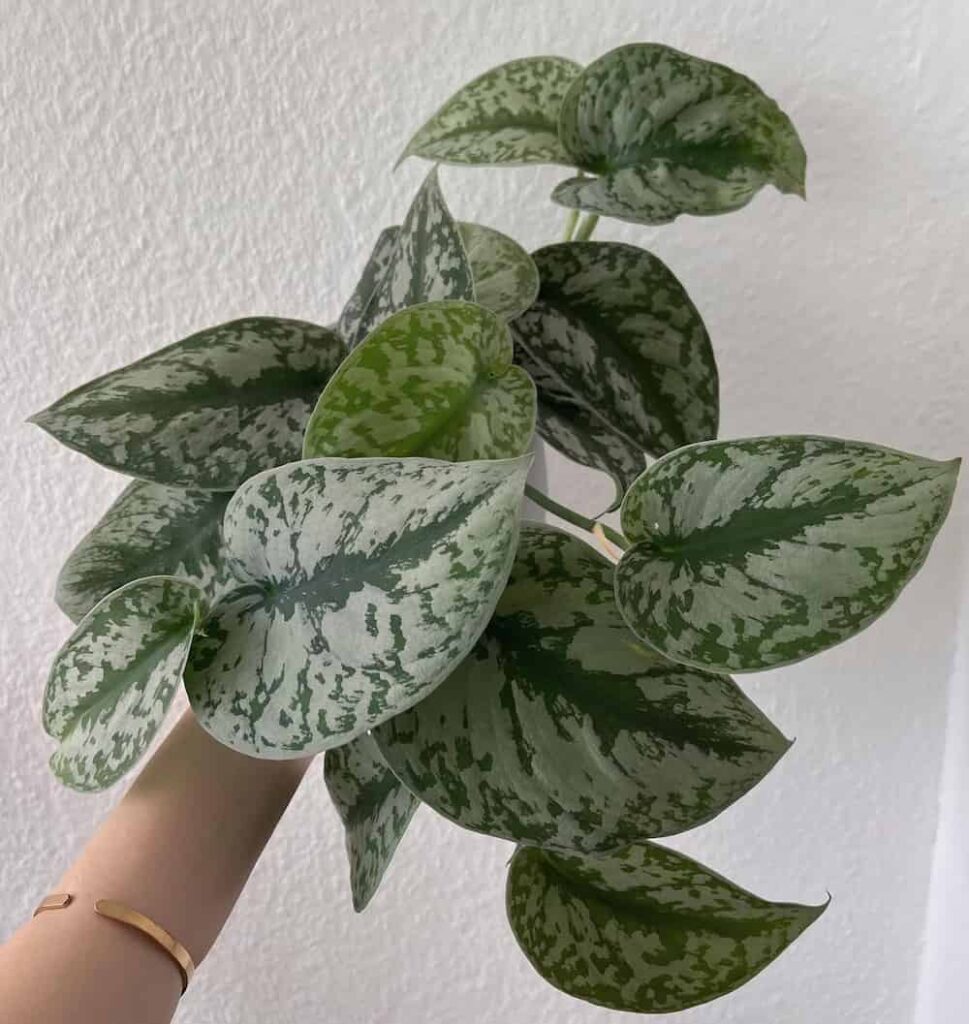
Why does my Silvery Ann pothos have yellow leaves?
Yellowing leaves can occur when the Silvery Ann pothos is exposed to temperatures that are too hot or too cold, as well as too much direct sunlight, and feeding the plant too much fertilizer. The good news is that all three of these reasons are easy to fix.
Make sure that the Silvery Ann pothos is in a room where the temperature stays between 65 and 85 degrees at all times, and avoid growing the plant in direct sunlight. Instead, select a spot where the plant can get bright, indirect light, such as near a window that has a sheer curtain. As for the too much feeding, simply stop applying fertilizer to the plant.
How do you make a Scindapsus Silvery Ann bushier?
The best way to make your Scindapsus Silvery Ann bushier is to prune the plant frequently and correctly. This helps to encourage growth, which will give the plant a bushier appearance and reduce the chance of it becoming leggy.
Experts recommend pruning the plant once or twice a month, trimming back the long stems and dead foliage. When trimming, use a sharp pair of shears to make the clean cuts, and do so just under the lead node.
Before tossing the pruned stems from the Silvery Ann pothos, consider using them to propagate the plant. As long as the stems are healthy and have a few leaves, you can root them in either soil or water.
Why is my Scindapsus Silvery Ann not growing
One of the quickest ways to prevent your Scindapsus Silvery Ann from growing is to not give the plant its ideal growing conditions. Even though they are not picky plants, the Silvery Ann pothos still needs an environment as close to its native habitat in order to thrive and grow properly.
This means that if your plant isn’t growing, start looking at how you have been caring for it.
Are you making sure the Silver Ann pothos has bright yet indirect sunlight? Are you allowing the soil to dry out a little between waterings? Are you keeping it in an area where the temperature is constantly between 65 and 85 degrees?
If you cannot say yes to each one of those questions, then you are not giving Silvery Ann pothos the conditions it needs to grow. Reevaluate the plant’s current growing conditions and then adjust them so that the Scindapsus Silvery Ann has what it needs to thrive in your home.
